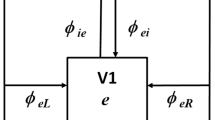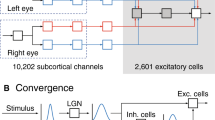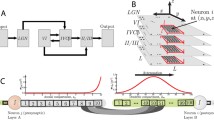Abstract
We present a neural network model for the formation of ocular dominance stripes on primate visual cortex and examine the generic phase behavior and dynamics of the model. The dynamical equation of ocular dominance development can be identified with a class of Langevin equations with a nonconserved order parameter. We first set up and examine an Ising model with long-range interactions in an external field, which is equivalent to the model described by the Langevin equation. We use both mean-field theory and Monte-Carlo simulations to study the equilibrium phase diagram of this equivalent Ising model. The phase diagram comprises three phases: a striped phase, a hexagonal ‘bubble’ phase, and a uniform paramagnetic phase. We then examine the dynamics of the striped phase by solving the Langevin equation both numerically and by singular perturbation theory. Finally, we compare the results of the model with physiological data. The typical striped structure of the ocular dominance columns corresponds to the zero-field configurations of the model. Monocular deprivation can be simulated by allowing the system to evolve in the absence of an external field at early times and then continuing the simulation in the presence of an external field. The physical and physiological applications of our model are discussed in the conclusion.
Similar content being viewed by others
References
Elder, K. R. and Grant, M.: J. Phys. (London) A23 (1989), L803.
Eschenfelder, A. H., Magnetic Bubble Technology, Springer-Verlag, Heidelberg, 1981.
Roland, C. and Desai, R. C.: Phys. Rev. B. 42 (1990), 6658.
Murray, J. D.: Mathematical Biology, Springer-Verlag, Berlin Heidelberg, 1989, pp. 372–592.
LeVay, M., Connoly, M., Houde, J. D., and van Essen, D. C.: J. Neurosci. 5 (1985), 486.
Wiesel, T. N.: Nobel Lecture, Biosci. Reports 2 (1982), 351.
A summary of our theory together with some of the results presented here is contained in two papers [8,9] both of which were published in conference proceedings. An overview of experiments performed on animals with normal visual experience can also be found in these publications.
Thomson, J. R.: MSc Thesis, McGill University, 1989; Thomson, J. R., Cowan, Wm., Zuckermann, M. J., and Grant, M.: in A. E. Gonzalez, M. Medina-Noyola, and C. Varea (eds.), Lectures on Thermodynamics and Statistical Mechanics, Proceedings of the XVIII Winter Meeting on Statistical Physics, Oaxtepec, Mexico, World Scientific, Singapore, 1989, pp. 38–51.
Thomson, J. R., Zhang, Z., Cowan, Wm., Grant, M., Hertz, J. A., and Zuckermann, M. J.: in K. Kaski and M. Salomaa (eds.), Proceedings of the Third Nordic Conference on Computer Simulation in Physics, Chemistry, Biology and Mathematics, Lahti, Finland, Topical Issue of Physica Scripta T33, 1990, pp. 102–109.
Hebb, D. O.: Organization of Behavior, Wiley, New York, 1949.
Dow, B. M., Vautin, R. G., and Bauer, R.: J. Neursci. 324 (1982), 221.
Gunton, J. D. and Droz, M.: The Theory of Metastable and Unstable States, Springer-Verlag, Heidelberg, 1983.
Møller, P.: MSc Thesis, Niels Bohr Inst., University of Copenhagen, 1987.
Møller, P., Nylén, M., and Hertz, J. A.: in R. Eckmiller and C. von der Malsburg (eds.), Neural Computers, Springer-Verlag, Heidelberg, 1988, pp. 139–148.
Mouritsen, O. G.: Computer Studies of Phase Transitions and Critical Phenomena, Springer-Verlag, Heidelberg, 1984.
Kawasaki, K.: Phys. Rev. A31 (1985), 3880.
Suzuki, M. J.: J. Stat. Phys. 16 (1977), 11.
Swift, J. and Hohenberg, P. C.: Phys. Rev. A 15 (1977), 319.
Swindale, N. V.: Proc. Roy. Soc. Lond. Series B 208 (1980), 243; ibid. 245 (1989), 605.
Miller, K. D., Keller, J. B., and Stryker, M. P.: Science 245 (1980), 605.
Lyons, M. J. and Harrison, L. G.: to be published.
Singer, W., Tretter, F., and Vinon, R.: J. Neurosci. 5 (1985), 890.
Author information
Authors and Affiliations
Rights and permissions
About this article
Cite this article
Thomson, J.R., Cowan, W.M., Elder, K.R. et al. Neural networks with constrained inputs as models for pattern formation in primate visual cortex. J Biol Phys 18, 217–245 (1991). https://doi.org/10.1007/BF00417810
Received:
Issue Date:
DOI: https://doi.org/10.1007/BF00417810




